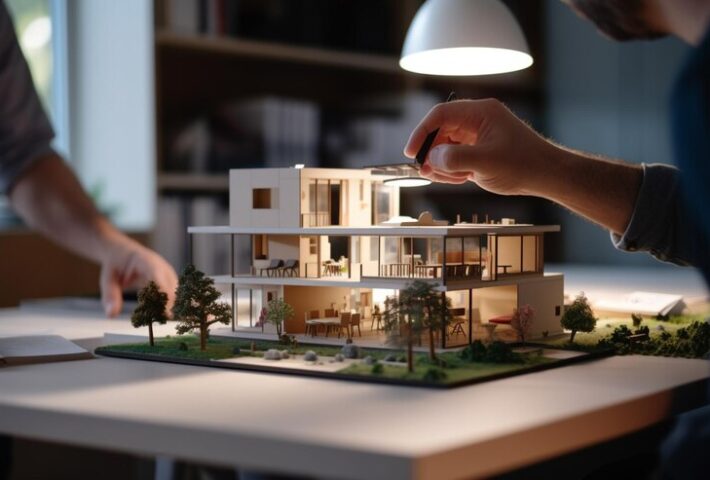
Role of Technology in Modern Civil Construction: IoT, Augmented & Virtual Reality, Robotics & Modern Construction in Civil Engineering
Building structures with manual equipment and methods is no longer common in the construction business. The development of technology has altered how we create, plan and oversee construction projects. Modern civil construction has become more efficient, safer and more cost-effective because to the use of technology. Following are some crucial elements to be considered as the best examples of using the modern technology in civil construction.
- Drones
Unmanned aerial vehicles (UAVs), commonly referred to as drones, are employed more frequently in the construction sector. Construction sites can be surveyed, data collected, and progress tracked using drones. Without the use of scaffolding or other tools, drones can survey difficult-to-reach regions like roofs and tall structures.
- Building Information Modeling (BIM)
Building information modelling (BIM) is a technique for digitally capturing a structure’s architectural and functional characteristics. A detailed 3D model of a building can be created using BIM software by architects, engineers, and construction experts. This model is then used to view, evaluate, and manage construction projects. BIM can decrease errors and minimise rework while also enhancing stakeholder engagement and communication.
- Augmented Reality (AR)
By superimposing digital data on actual items, augmented reality (AR) is an interactive experience that improves physical environments. AR technology can be applied in the building industry to simulate construction processes, visualise plans, and find potential issues. By giving instructions and information in real time, augmented reality (AR) can also be utilised to teach employees and increase safety.
- Virtual Reality (VR)
A computer-generated simulation of a three-dimensional environment is known as virtual reality (VR). Construction sites may be simulated, designs can be seen, and workers can be trained using VR technology. Before building starts, VR can be used to evaluate various design scenarios and find potential issues.
- Robotics
Robots are being employed more and more in the construction industry to automate dangerous and repetitive jobs like bricklaying, welding, and concrete pouring. By removing the need for human labour in dangerous situations, robotic technology can increase efficiency, lower costs, and improve safety.
- Internet of Things (IoT)
The Internet of Things (IoT) is a network of real-world equipment, machinery, structures, and other items that have connectivity, software, and sensors built in. IoT technology can be utilised in the building industry to track supply and materials, monitor machinery, and improve workflows. By identifying possible risks and warning workers, IoT can also be utilised to increase safety.
The way we build, develop, and manage construction projects has changed as a result of the use of technology in modern civil construction. Technology like BIM, drones, AR, VR, robotics, and IoT can be adopted to increase efficiency, cut costs, and increase safety. The importance of technology will only increase as the building sector develops more. We can create a better future for ourselves and future generations by embracing technology.
Augmented Reality Transforming Civil Engineering: Gamut Buildcon’s Innovative Approach
In the realm of civil engineering, Gamut Buildcon and EPC Company is making significant strides by harnessing the power of augmented reality in civil engineering. Augmented reality, a cutting-edge technology, seamlessly integrates digital information and virtual elements into the physical world, providing engineers with an enhanced view of their projects. Gamut Buildcon’s forward-thinking approach involves integrating augmented reality in civil engineering at various stages of project development. During the design phase, engineers utilize AR to overlay virtual models onto real-world environments, allowing for precise planning and accurate spatial analysis. This ensures that projects are seamlessly integrated into their surroundings, optimizing resource allocation and reducing potential conflicts.
Moving into the construction phase, AR-equipped helmets and smart glasses empower workers with real-time data and visual aids. This technology assists in tasks like structural alignment, ensuring unparalleled precision in execution. Moreover, augmented reality in civil engineering enables Gamut Buildcon to implement innovative safety protocols, enhancing worker awareness and mitigating potential hazards on-site. For clients, Gamut Buildcon goes the extra mile by utilizing augmented reality in civil engineering to provide immersive project presentations. Stakeholders can now visualize the final product in its intended environment, fostering clearer communication and eliminating misunderstandings. With this pioneering approach, Gamut Buildcon is redefining the standards of civil engineering. Their commitment to efficiency, precision, and client satisfaction is exemplified through the integration of augmented reality in civil engineering. By embracing this transformative technology, Gamut Buildcon solidifies its position as an innovative leader in the EPC sector. Augmented reality in civil engineering is not just a concept for Gamut Buildcon; it’s a reality that sets them apart in the industry.







